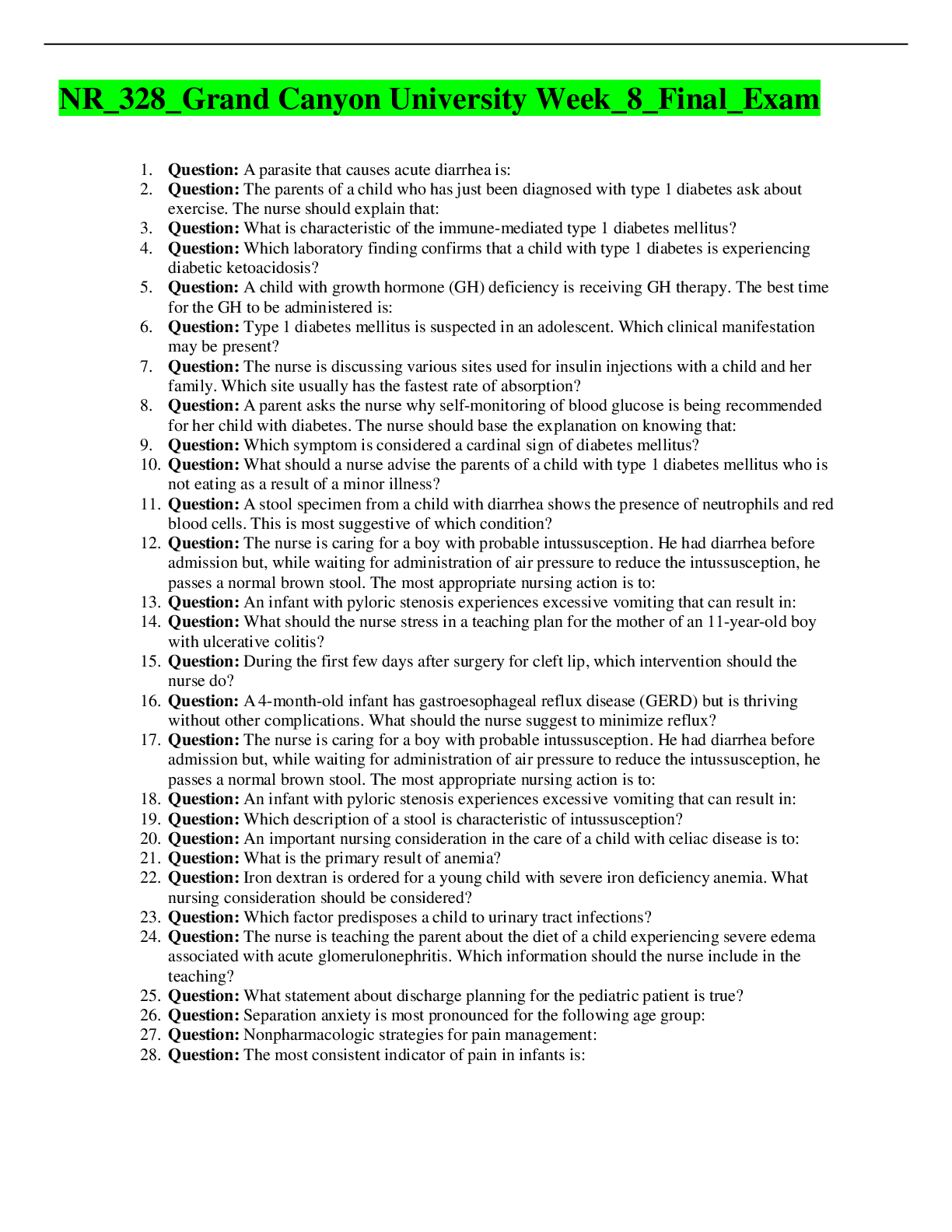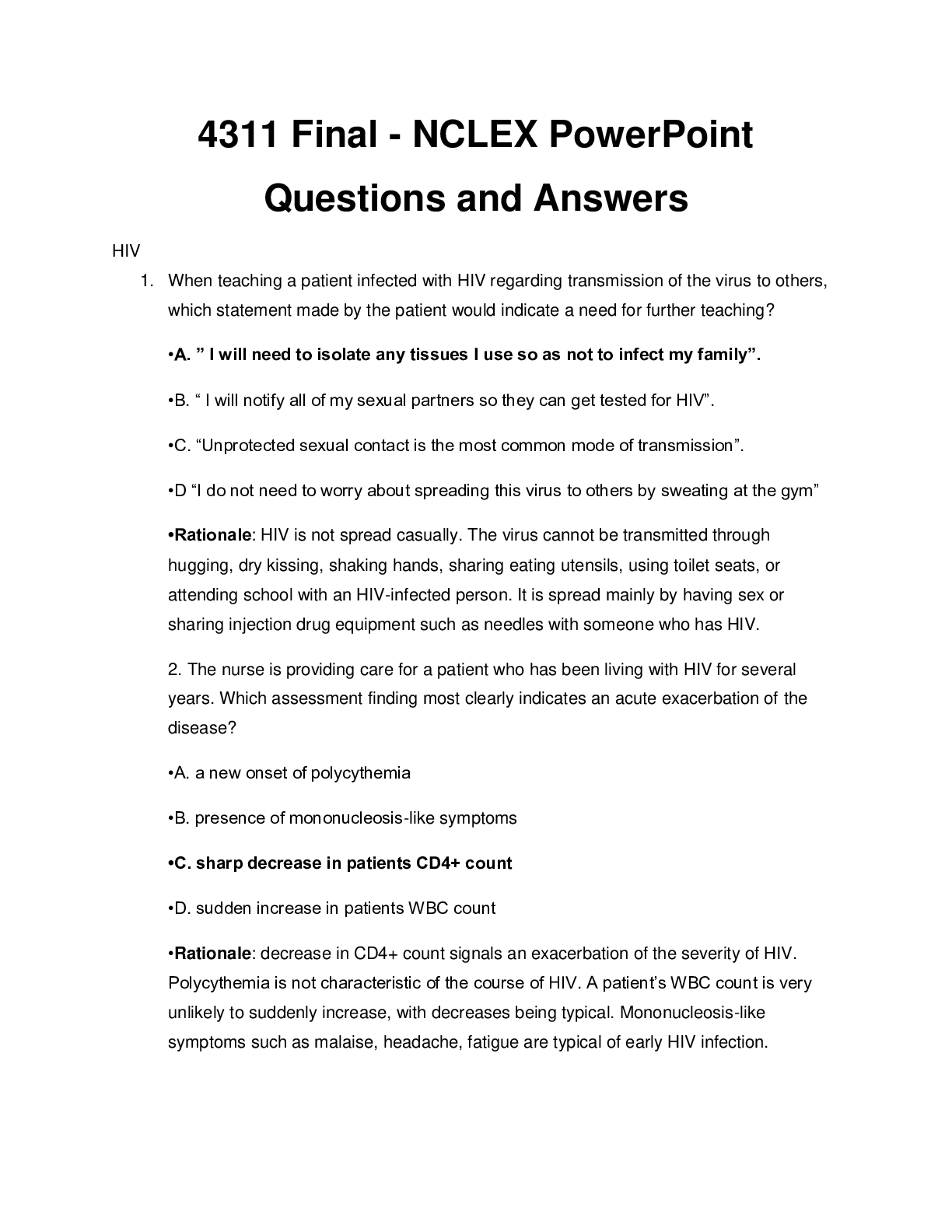*NURSING > QUESTIONS & ANSWERS > HESI RN Pediatrics V1, V2 and V3 Questions and Answers | 90 Latest Questions and Answers with Explan (All)
HESI RN Pediatrics V1, V2 and V3 Questions and Answers | 90 Latest Questions and Answers with Explanations, All Correct Study Guide.
Document Content and Description Below
HESI RN Pediatrics V1, V2 and V3 Questions and Answers 2021 (A Grade), Latest Questions and Answers with Explanations, All Correct Study Guide, Download to Score A HESI RN Pediatrics V1, V2 and V3 Qu... estions and Answers 2021 1. The nurse is performing a routine examination of a 6-month-old infant at community health clinic. Records indicate that the child weighed 3 kg at birth. The clinic uses lbs to describe weight. When assessing this child, approximately what weight, in lbs, should the nurse consider to be within normal range for this child? • 15 to 18 lb • 12 to 15 lb • 9 to 11.5 lb • 6 to 7.5 lb 2. When development a teaching plan for an adolescent male who was recently diagnosed with Type 1 diabetes mellitus, the nurse should instruct the to eat a source of sugar if which symptom occurs? • Excessive thirst • Racing pulse • Profuse perspiration • Seeing spots 3. A breast feeding mother returns to work when her infant is 5 months old. She is having difficulty pumping enough milk to meet her infant's dietary requirements. Which suggestion should the nurse provide to this mother? • Mix infant formula with breast milk • Supplement with an iron-rich formula • Introduce baby food for one meal daily • Offer a follow-up transitional formula 4. The nurse is assessing an infant with aortic stenosis and identifies bilateral fine crackles in both lung fields. Which additional finding should the nurse expect to obtain? • Vigorous feeding and satiation • Hemiplegia • Fever • Hypotension and tachycardia 5. The nurse should instruct the parent of an 8-year-old child who has sickle anemia to alert for which complaint from the child? • "I'm shorter than everyone else" • "I'm really hot and thirsty" • "I don't want to eat any vegetables" • "I have to urinate every few hours" 6. During a routine clinic visit, the nurse determines that 5-year-old girl's systolic blood pressure is greater than the 90th percentile. What action should the nurse implement next? • Take the blood pressure two more time during the visit and determine the average of the three readings • Measure the child's blood pressure three times during the visit and determine the highest of the readings • Conduct a head-to-toe assessment and omit repeat blood pressure during the examination • Refer child to the healthcare provider and schedule evaluation of blood pressure in two weeks 7. A one - month old male infant is brought to the clinic by his mother who states that her son has been vomiting forcefully after each meal for the last three days. The infant is afebrile, dehydrated, and pyloric stenosis is suspected. What other finding should the nurse identify that are consistent with pyloric stenosis? • Perianal diaper rash from persistent diarrhea • Rooting, hunger, and irritability • Bite-stained emesis • An olive-shaped mass in the abdominal area 8. The nurse is evaluating a young child with atopic dermatitis. Which question should the nurse ask the parent while obtaining the child's history? • Does the child have any nausea or vomiting? • Has the child displayed any symptoms of asthma or hay fever? • What time of day does the rash appear on the body? 9. A 3-month-old with myelomeningocele and atonic bladder is catheterized every 4 hours to prevent urinary retention. The home health nurse note that the child has developed episodes of sneezing, urticaria, watery eyes, and a rash in the diaper area. What action is most important for the nurse to take? • Auscultate the lungs for respiratory pneumonia • Draw blood to analyze for streptococcus infection • Change to latex - free gloves when handling infant • Apply zinc oxide to perineum with each diaper change 10. A 12-year-old is admitted to the hospital with possible encephalitis, and a lumbar puncture is schedule. Which information should the nurse provide concerning to this procedure? • Explain that fluids cannot be taken for 8 hours before the procedure and 4 hours after the procedure • Tell the child to expend loud clicking during the procedure that may be annoying • Describe the side-lying, knee to the chest position that must be assumed during the procedure • Reassure the child that there will be no restrictions on activity after the procedure is completed [Show More]
Last updated: 6 months ago
Preview 5 out of 31 pages

Loading document previews ...
Buy this document to get the full access instantly
Instant Download Access after purchase
Buy NowInstant download
We Accept:

Reviews( 0 )
$15.00
Can't find what you want? Try our AI powered Search
Document information
Connected school, study & course
About the document
Uploaded On
May 05, 2021
Number of pages
31
Written in
Additional information
This document has been written for:
Uploaded
May 05, 2021
Downloads
0
Views
224
, Latest Questions and Answers with Explanations, All Correct Study Guide, Download to Score A.png)


 Questions and Answers (latest Update), All Correct, Download to Score A.png)






, (A Grade), Questions and Answers, All Correct Study Guide, Download to Score A.png)
, Questions and Answers, All Correct Study Guide, Download to Score A.png)
, Latest Questions and Answers with Explanations, All Correct Study Guide, Download to Score A.png)













